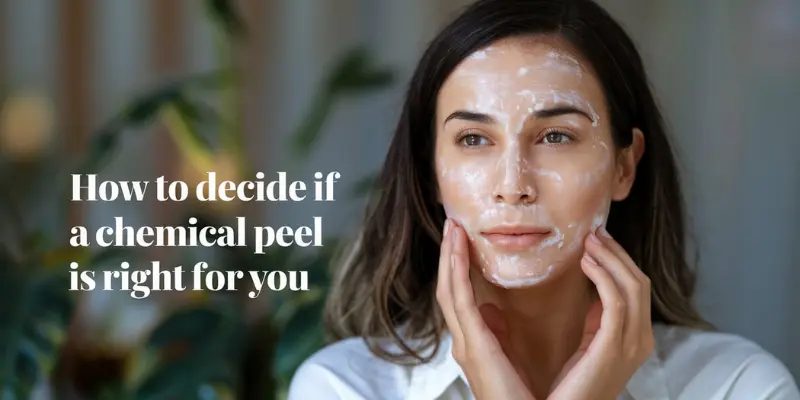The Pros and Cons of Chemical Peels
Published: 16 Mar 2025
Are you thinking about trying a chemical peel for better skin? This popular skincare treatment can help reduce wrinkles, acne scars, and dark spots, while giving your skin a smoother, brighter look. Many people love chemical peels because they can improve skin tone and texture without surgery.
But like any skin treatment, chemical peels also come with some risks. In this guide, we’ll explain the main pros and cons of chemical peels in simple words, so you can decide if it’s right for your skin. Whether you want to treat acne, fine lines, or dull skin, this blog will help you make a smart, safe choice.
The Pros of Chemical Peels

Chemical peels can do wonders for your skin by improving its texture, tone, and overall appearance.
Here’s a breakdown of how they can benefit your skin:
- Improves Skin Texture and Tone
- Reduces Fine Lines and Wrinkles
- Treats Acne and Blemishes
- Brightens Skin
- Non-Invasive with Quick Recovery
Let us cover all in detail.
1. Improves Skin Texture and Tone
A chemical peel helps even out your skin tone by removing the outer layer of dead skin. This process can fade dark spots, sun damage, or acne scars, making your skin look smoother and more even.
- Example: If you’ve had acne scars or sunspots, a chemical peel can help reduce their appearance and give your skin a healthier look.
2. Reduces Fine Lines and Wrinkles
Chemical peels are great for smoothing out fine lines and wrinkles, especially around your eyes, mouth, and forehead. By removing the top layers, they help your skin renew itself, making you look more youthful.
- Tip: After a few treatments, you’ll start noticing a smoother skin surface and a fresher appearance.
3. Treats Acne and Blemishes
If you struggle with acne, a chemical peel can help. It works by cleaning out your pores and preventing new breakouts. Peels also treat existing blemishes by clearing out the dead skin that clogs your pores.
- Example: Regular peels can reduce the number of breakouts and even help prevent future ones.
4. Brightens Skin
One of the best things about chemical peels is how they brighten up your skin. After the peel, your skin can look fresher and more radiant, almost like a glow-up.
- Tip: If you have dull, tired skin, a peel can bring it back to life, giving you that fresh glow you’ve been looking for.
5. Non-Invasive with Quick Recovery
Chemical peels are less invasive compared to other treatments like laser therapy or surgery. They don’t require cuts or stitches, and the recovery time is usually quick, with minimal downtime. Most people can return to their regular routine in just a few days.
- Comparison: Unlike surgery, which can take weeks to heal, a chemical peel gives you results without the lengthy recovery time.
The Cons of Chemical Peels

Chemical peels can give your skin a fresh start, but they do come with some downsides. It’s essential to be aware of these risks so you can make the best decision for your skin.
Here’s a breakdown of how they can be harmful to your skin:
- Risk of Skin Irritation
- Possible Scarring
- Downtime and Recovery
- Not Suitable for Everyone
- Cost
Let us cover all in detail.
1. Risk of Skin Irritation
One of the most common side effects after a chemical peel is skin irritation. This can show up as:
- Redness: Your skin may look a bit flushed, like a mild sunburn.
- Dryness: Your skin might feel tight and dry as it starts to heal.
- Flakiness: As the old skin sheds, you may notice some peeling or flaking.
These effects are normal, but they can be uncomfortable for a few days. The good news is, this is usually temporary, and your skin will start to look smoother and fresher as it heals.
2. Possible Scarring
Although rare, chemical peels, especially the deeper ones, can leave scars. Scarring is more likely with:
- Deep peels: These target the deeper layers of your skin, so if something goes wrong, there’s a higher chance of scarring.
- Improper aftercare: If you don’t follow the recovery instructions carefully, the risk of scarring can increase.
Scars are not something you want, so it’s important to choose the right peel for your skin type and to follow all aftercare advice given by your dermatologist.
3. Downtime and Recovery
Chemical peels don’t give instant results. After the treatment, your skin needs time to recover. Depending on the type of peel you get, here’s what you can expect:
- Superficial peels: These have the shortest recovery time. You might experience some redness and flaking for a few days, but you can usually go back to your normal routine quickly.
- Medium peels: These might take a week or more to fully heal. Your skin may peel and feel tender during this time.
- Deep peels: These can take weeks to heal, and you might need to take time off work or avoid social events because of the redness, peeling, and swelling.
The deeper the peel, the longer the recovery time. Be prepared for some downtime and follow aftercare instructions carefully to avoid complications.
4. Not Suitable for Everyone
Chemical peels are not the right choice for everyone. People with certain skin types or conditions may not be good candidates for this treatment. For example:
- Sensitive skin: If your skin is easily irritated or reacts to skincare products, a chemical peel might make things worse.
- Active skin conditions: Conditions like eczema, rosacea, or psoriasis can flare up after a peel.
- Pregnancy: Pregnant women are often advised to avoid chemical peels, as the chemicals used may not be safe during pregnancy.
It’s always best to consult with a dermatologist before deciding on a peel, especially if you have sensitive skin or other skin issues.
5. Cost
Chemical peels, especially the deeper ones, can be costly. Prices vary depending on the type of peel and where you get it done. Here’s a general idea:
- Superficial peels: These tend to be the least expensive, ranging from $150 to $300.
- Medium peels: These can cost between $500 and $1,000, depending on the location and professional.
- Deep peels: These are the most expensive, often costing $2,000 or more.
If you’re on a budget, be prepared for the cost, especially if you’re considering a more intense peel.
How to Decide if a Chemical Peel Is Right for You

Choosing a chemical peel isn’t always easy, but considering a few key factors can help you decide if it’s the right choice. Think about your skin type, budget, and what you hope to achieve. It’s important to know what you’re getting into before making a decision.
Factors to Consider:
- Skin Type: If you have sensitive skin, a chemical peel might irritate your skin. If your skin is oily, dry, or a mix of both, certain peels might work better for you.
- Budget: Chemical peels can be expensive, especially deeper treatments. Make sure the cost fits into your budget.
- Desired Results: Are you looking to treat fine lines, acne scars, or uneven skin tone? The kind of peel you need depends on your goals.
It’s always a good idea to consult a dermatologist or skin care professional. They can help you understand what’s best for your skin and guide you through the process. This way, you can avoid risks and get the results you want.
Conclusion
A chemical peel can help your skin look better by reducing wrinkles, acne scars, and making your skin tone more even. It can also make your face feel smooth and look fresh.
But remember, chemical peels are not for everyone. Some people may get redness, dryness, or even scars if not done right. Always talk to a skincare expert before getting a peel. With the right care, a chemical peel can be a safe and helpful way to improve your skin health and appearance.

- Be Respectful
- Stay Relevant
- Stay Positive
- True Feedback
- Encourage Discussion
- Avoid Spamming
- No Fake News
- Don't Copy-Paste
- No Personal Attacks

- Be Respectful
- Stay Relevant
- Stay Positive
- True Feedback
- Encourage Discussion
- Avoid Spamming
- No Fake News
- Don't Copy-Paste
- No Personal Attacks






